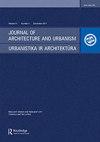ECO-INTEGRATIVE TERRITORIAL EVOCATION BY EMERGING NEW ARCHITECTURAL ECO-CLIMATIC STYLE
IF 0.8
0 ARCHITECTURE
引用次数: 0
Abstract
In this research work, the interest is directed towards the evocation of innovative neo-architectural dynamics in the Tunisian south-east territory, through an eco-integrative approach and the production of new eco-climatic architectural styles, based on the natural and cultural wealth of the Tunisian territory, authentic and revolutionary, yet marginalized and restricted, giving rise to reactions to the question that arises: “Is the situation of the vernacular heritage in the Tunisian south-east the direct result of a lack of vernacular heritage potential knowledge lack or of a modernist, restricted and reductive architectural production?” A multi-scale architectural study of rustic heritage has been developed, including a morpho-metric study, the analysis of hygrothermal diagrams produced in situ as well as the measurement of temperature and humidity inside the spaces. Neotroglodytic architecture, allows to highlight the intelligible integration of this new architectural mode in the mineral and arid desert landscape and to detect the aspect of an ecological and sustainable architecture, offering a humble, comfortable and welcoming intra-spatial atmosphere. Otherwise, in southeastern Tunisia, diagnostics have shown that rural villages, partially occupied and exploited in an anarchic manner, are subject to real dangers that threaten their survival in the Saharan territory, considered a difficult area. Direct consequences of an unsuitable development process, these historic works are perceived as static in the face of a dynamic social process, which has led to the gradual increase in their abandonment rates. Similarly, a disfigurement of the rustic landscape results from poor adaptation due to the standardized reproduction of architectural styles “in search of modernity”. The new troglodyte modes present a versatile and capacitive cultural potential. The manifestation of cultural and spatial wealth thus emerges, with the lasting potential of constituting a vector of cultural transition for the territorial development of southeastern Tunisia.新兴建筑生态气候风格的生态一体化地域召唤
在这项研究工作中,通过生态一体化的方法和基于突尼斯领土的自然和文化财富的新的生态气候建筑风格的生产,关注突尼斯东南部地区创新的新建筑动态,真实和革命性,但被边缘化和限制,引起对出现的问题的反应:“突尼斯东南部乡土文化遗产的现状是缺乏乡土文化遗产潜在知识的直接结果,还是缺乏现代主义、受限制和简化的建筑生产的直接结果?”对乡村遗产进行了多尺度的建筑研究,包括形态测量研究、现场产生的湿热图分析以及空间内温度和湿度的测量。新石器时代的建筑,可以突出这种新建筑模式在矿物和干旱沙漠景观中的可理解性整合,并检测生态和可持续建筑的方面,提供谦虚,舒适和欢迎的空间氛围。此外,在突尼斯东南部,诊断结果表明,在被认为是困难地区的撒哈拉领土上,部分被无政府主义占领和剥削的农村面临威胁其生存的真正危险。不适当的发展过程的直接后果,这些历史作品被认为是静态的面对一个动态的社会进程,这导致了他们的遗弃率逐渐增加。同样,由于“追求现代性”的建筑风格的标准化复制,导致乡土景观的毁容。新的穴居人模式呈现出一种多用途和容性的文化潜力。由此出现了文化和空间财富的表现形式,具有构成突尼斯东南部领土发展的文化转型载体的持久潜力。
本文章由计算机程序翻译,如有差异,请以英文原文为准。
求助全文
约1分钟内获得全文
求助全文
来源期刊

Journal of Architecture and Urbanism
ARCHITECTURE-
CiteScore
1.30
自引率
14.30%
发文量
12
审稿时长
15 weeks
期刊介绍:
The Journal of Architecture and Urbanism publishes original research on all aspects of urban architecture.
 求助内容:
求助内容: 应助结果提醒方式:
应助结果提醒方式:


